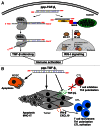Breaking tumor-induced immunosuppression with 5'-triphosphate siRNA silencing TGFβ and activating RIG-I
- PMID: 23762798
- PMCID: PMC3667904
- DOI: 10.4161/onci.24170
Breaking tumor-induced immunosuppression with 5'-triphosphate siRNA silencing TGFβ and activating RIG-I
Abstract
Retinoic acid-inducible gene I (RIG-I) is a pattern recognition receptor that is activated by 5'-triphosphate RNA molecules to induce type I interferon secretion and apoptosis in response to viral infection. We have designed a bifunctional small-interfering RNA that combines transforming growth factor β silencing with RIG-I activation to break tumor-induced immunosuppression. This strategy showed therapeutic efficacy in a murine model of pancreatic cancer.
Keywords: RIG-I; TGFβ; immunosuppression; pancreatic cancer; siRNA.
Figures

References
LinkOut - more resources
Full Text Sources
Other Literature Sources
